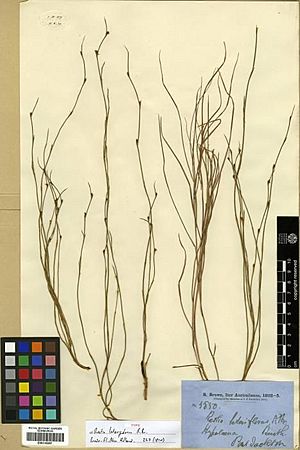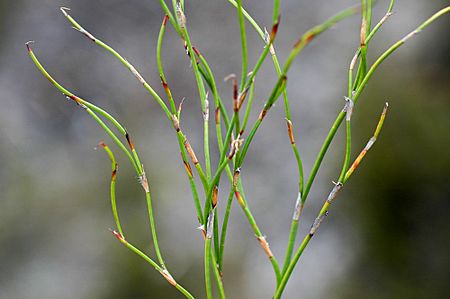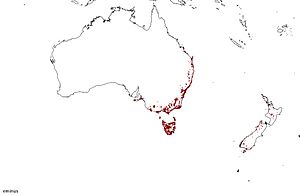Wire rush facts for kids
Quick facts for kids Wire rush |
|
|---|---|
 |
|
| Empodisma minus on a herbarium sheet. | |
| Scientific classification | |
| Genus: |
Empodisma
|
| Species: |
minus
|
Empodisma minus, also known as wire rush or spreading rope-rush, is a special type of plant. It's an evergreen, meaning it stays green all year round. This plant belongs to a family called Restionaceae, which mostly grows in the Southern Hemisphere.
The name Empodisma minus comes from Latin. It means "tangle-foot" and "small." You can find this plant in many places. It grows from Queensland to South Australia and Tasmania. It's also found across New Zealand, especially in the southern parts.
Scientists currently say Empodisma minus is "Least Concerned." This means it's not in danger of disappearing. In 2012, a new species, Empodisma robustum, was discovered in New Zealand. Some plants once called E. minus are now known as E. robustum. Still, E. minus is very important for forming peat in southern New Zealand. It also helps create peat in high-altitude wetlands.
Contents
What Empodisma minus Looks Like
This plant has stems that can be anywhere from 15 to 200 centimeters long. They are often dark green or dark brown. Shorter stems stand straight up. Taller stems tend to lie down.
The stems have small leaf-like parts called sheaths. These sheaths are 5.5 to 12 millimeters long. They make the stem look like it's divided into many sections. These sheaths stay close to the stem. They also have tiny white hairs where they join the stem.
The plant's flowers grow in structures called spikelets. These are the main flower clusters. Male and female spikelets usually grow alone and directly on the stem. The fruit of E. minus is a hard, oval-shaped nut. It is about 2 millimeters long and also grows directly on the stem.
Underground, the plant has a strong root system called a rhizome. This rhizome is about 8 millimeters wide. Many roots grow horizontally from it.
Life Cycle and Reproduction
Empodisma minus flowers from August through December. Its flowers are yellow. The fruits then appear from November until March.
Where Empodisma minus Lives
You can find Empodisma minus most commonly in southeastern Australia. It's also in Tasmania. However, it does not grow in Western Australia or the Northern Territory. This plant is also found throughout New Zealand.
In both Australia and New Zealand, it grows from coastal areas all the way up to high mountain regions. It prefers wet places like fens (grassy wetlands), bogs (spongy wetlands), heaths (open shrublands), swamps, and the edges of streams.
How Empodisma minus Survives
Plants in the Restionaceae family, including Empodisma, are tough. They can grow in soils that don't have many nutrients. They can also survive periods of dry weather.
Sometimes, E. minus might experience fires. Fires can harm the plant, but it can slowly grow back. This ability to regrow is called resprouting.
In New Zealand, Empodisma minus often grows in a thick mat. It shares its space with other plants like Leptospermum scoparium (a heath shrub), Baumea teretifolia (a sedge), and ferns like Gleichenia dicarpa and Gleichenia microphylla. It also grows with Sphagnum cristatum (a type of moss).
Empodisma minus is a very important plant in New Zealand's bogs. It's known for its great ability to form peat. Because of this, it's sometimes called an ecosystem engineer. This means it helps shape its environment, especially in changing fens into bogs.
In Australia, Empodisma minus grows alongside plants like Richea continentis and Baeckea gunniana (shrubs). It also grows with the fern Gleichenia alpina, Sphagnum cristatum (moss), and Astelia alpina (another type of plant). Dry seasons can cause the plant material to break down. This limits how much peat forms. However, wet seasons help the plant's roots grow and build up peat.
Empodisma minus is also a host plant for a special moth. The larvae (baby moths) of the New Zealand moth Aponotoreas synclinalis feed on Empodisma minus.



